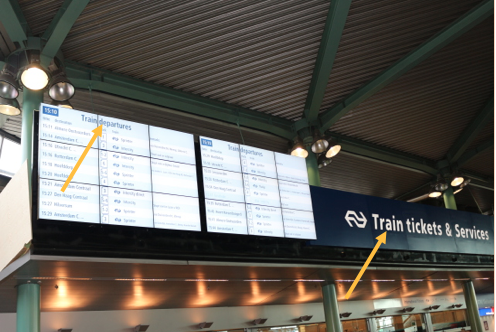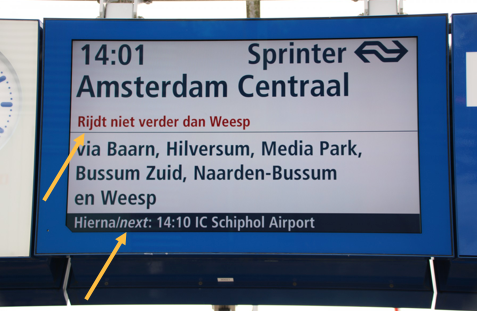
The Dutch Railways' Language Policies
If you travel by train in the Netherlands, you are, at the beginning of your trip greeted by a (cheerful) message from the train conductor, telling you exactly where the train journey will take you. I myself, as someone who travels frequently by train, have always been fascinated by the fact that sometimes the train conductor repeats the travel information very extensively in English, whereas other times it is solely provided in Dutch.
The English language is present, but this does not seem to be the case in a structured manner. It does, however, indicate that the Nederlandse Spoorwegen (NS; Dutch Railways) feel the need to include another language besides the national language of the Netherlands. It made me wonder what language policy the NS maintain and why they operate the way as they do regarding their language use?
English is present - but not everywhere
To find out more about the NS' language policies, I decided it was best to first talk to an actual employee. Luckily, one of my acquintances happens to be a train conductor at the Dutch Railways. When asked about the rules regarding language usage, he told me that there is no language policy regarding the oral broadcast messages of the current train conductors (B. Willems, personal communication, March 11th, 2018). He informed me that whenever a message is broadcasted in English, this is the employee's own initiative.
It is different, however, for NS International, i.e. the trains that cross the border and go abroad. The employees of these trains are required to use other languages besides Dutch. Usually these are French, German and English. So, the language in which oral information is provided to train travelers in the Netherlands is basically left to the opinion and need of the train conductor to do so. But what about the "rules" regarding written information on NS train stations?
If you start making observations, it is noticiable that a lot more signs are available in English nowadays. At Schiphol Airport, English has even replaced the Dutch language; most of the signs are solely in English (see Figure 1). This makes sense, since a lot of tourists that travel to the Netherlands arrive at this airport and travel further into the country from this train station.
However, when a delay or another type of complication with the train occurs, that information is mostly only provided in Dutch. As you can see in Figure 2, the NS do offer some translation into English, but not everything is indeed translated. This once more indicates the inconsistency in language use.

Figure 1: 1: The use of English at Schiphol Airport. The orange arrows point at the English words
Since talking to an employee and observing the actual language practices still did not give me a clear insight in what, if any, language policy the NS maintain, I decided to look online for language policy documents. These (if any) were unfortunately not available to the public.
I did find, however, that one of the job requirements for train conductors and service employees is having a good proficiency in both Dutch and English (vacancies of NS). This could point to the fact that it is actually a requirement for their staff to provide information in Dutch, as well as in English, or it could indicate that the NS want to improve their use of English by making speaking this language a requirement for future employees.

Figure 2: The use of English at an information sign. The complication of the train is not translated in English.
When contacting the NS customer service, first and most importantly, they told me that the information for Dutch speakers always comes first (NS Customer Service, personal communication, March 21st, 2018). It is legally required to provide the traveler with Dutch travel information.
English will, however, become more and more present throughout the whole country (as we already saw in the example of Schiphol Airport). The NS anticipate a the growing number of tourists and these people also want to be informed. The NS customer service told me that this means that bigger stations will provide information in English. What stations exactly qualify for this, is determined by the NS.
What I found most interesting about this last piece of information, is that the NS states that it only starts to provide messages in English because of tourists. There are, however, many Dutch citizens in the Netherlands that are not fully proficient in Dutch and use the English language more often. These people may not live around the “bigger” stations and therefore NS does not cater to the needs of these specific people.
Moreover, it's interesting that the NS have only started to shift more towards a greater use of English, whereas English has been present in Dutch society for a long time already. This is especially remarkable since they did very rapidly change the “ladies and gentlemen” part in their welcoming broadcast message to a gender neutral “dear travelers". This indicates that the company is indeed capable to change their language policy to cater to more people's needs
A policy based on initiative
When looking at the Dutch Railways' language policies from an analytical point of view, their sporadic use of English clearly illustrates that what happens at the top of policy-making does not always coincide with what happens on the ground. The policy maker, which in this case is the NS, has a certain aim, i.e. a situation where they want to arrive. That is, they want to be able to also communicate with non-Dutch speaking train travelers, specifically tourists. They find it important that all their passengers are informed properly.
In an ideal policy-making process, this aim is promoted by well-defined means of actions, which are carried out by the different actors involved in the policy-process, which are (1) the policy makers, (2) the policy implementers, and (3) the target group. Especially the latter is important, because without any real cooperation or coproduction of the target group, a policy cannot be successfully implemented (Kroon, 2000). This is where the NS' problem lies.
The NS should transfer more clearly to their employees what the aims and means are regarding their use of English
The target group of the English language policy of the NS does not only consist of non-Dutch speaking train travelers, but also of the policy implementers, which are the NS employees. The cooperation of the latter especially is very important, because they are the ones that decide to apply the English language in their communications or not.
Since the use of English is currently left to the employees, it will depend on the individual whether they experience a lack of English in the provision of information as a problem or not. If they don't, this means that they won't change their language use in their communications.
The NS can therefore provide dozens of signs in English at train stations, but if some use of English keeps being based on the initiative of the employees, and some do not feel the need to do so, then the provision of English information will always be lacking. Furthermore, as we could see from the examples even the provision of English in information signs does not seem to be as effective as it could be yet.
Need for a more structured and clear language policy
The examples discussed in this article show that at this stage there is no consistency in the provision of information in English by the NS. Decisive for the willingness on the side of the target group to cooperate is a clear vision of the policy’s means and aims and the benefits that are expected when implementing these (Kroon, 2000). Apparently, this clear vision is lacking. There does not seem to be a very clear-cut and guiding policy.
The NS should therefore transfer more clearly what the aims and means are regarding their use of English to their employees and carry out the means in a consistent manner. If not, English will never be granted the full status of language of instruction. Furthermore, I think it is important for the NS as a policy maker to implement a language policy that is not only targeted at travelling tourists, but at all non-Dutch speaking train travelers. In this way, they are more inclusive and accommodate the needs of more citizens, just as they do with their gender neutral broadcast messages.
References
Kroon, S. (2000). Language policy development in multilingual societies. In M. den Elt, & T. van der Meer (Eds.), Nationalities and Education: Perspectives in policy-making in Russia and the Netherlands: Issues and methods in language policy and school-parents relationship (pp. 15-38). Utrecht: Sardes.